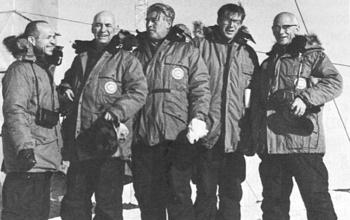![]()
Press Statement 14-001
Philip M. Smith, former Polar Programs deputy director and advocate for U.S. International Polar Year involvement, dies at 81![]()
Helped to built essential momentum for the IPY across the federal government
|
Phil Smith (second from right) in Antarctica with rocketry pioneer Wernher von Braun (center). |
March 31, 2014
Philip M. Smith, a pioneering polar researcher and former deputy director of what was, at the time, the Office of Polar Programs (OPP) at the National Science Foundation (NSF), died on Feb. 16. The New Mexico resident was 81.
Smith, who came to NSF in 1958, began his association with U.S. National Programs in Polar Regions in 1955. While in the U.S. Army, he spent a year in Greenland and, during the International Geophysical Year (IGY), he developed a tractor traverse between Antarctica’s Little America V and Byrd stations. During the 1957-1958 research season, Smith, employed by the Arctic Institute of North America, did glaciological research at Camp Michigan on the Ross Ice Shelf and later was dispatched to McMurdo Station to assist in post-IGY transitional activities.
Prior to becoming deputy OPP head OPP in 1970, Smith was director of field requirements and coordination in what was formerly the Office of Antarctic Programs.
According to a 1974 article in the Antarctic Journal of the United States, several logistics innovations evolved under his leadership. These include the Unmanned Geophysical Observatory, the under-ice observation chamber, development and use of a pre-fabricated module for station construction, use of ski-equipped LC-130 aircraft in field program support, and the use of helicopters to increase mobility in the McMurdo Dry Valleys. All of these innovations promoted new, or more effective, scientific observations.
He also encouraged such programs as the International Antarctic Glaciological Project and the Dry Valley Drilling Project, and was active in U.S. contributions to the Scientific Committee on Antarctic Research (SCAR). In the late 1960s and early 1970s, Smith was involved in policy and management studies related to the transfer of Antarctic program responsibilities from the Department of Defense to NSF.
From 1975 to 1981, Smith served as associate director for for natural resources, energy and science in the White House Office of Science and Technology Policy.
Several years after he retired from the National Research Council (NRC), Smith took up the challenge of planning for an active U.S. program for International Polar Year (IPY) 2007-2009.He was credited with personally persuading the presidents of the U.S. National Academies to sponsor a planning workshop at the NRC, volunteered to serve as the workshop moderator, and summarized the workshop conclusions in what proved to be a highly influential report.
The report, delivered in mid-2004, defined principal U.S. IPY goals for polar research, education and logistics and built essential momentum for the effort across the federal government.
NSF was designated as the lead U.S. agency for IPY.
In honor of his extraordinary accomplishments, two geographic features in Antarctica are named for him: Smith Bluffs and Smith Glacier. Both are in West Antarctica.
-NSF-
![]()
Media Contacts
Peter West, NSF, (703) 292-7530, pwest@nsf.gov
![]()
The National Science Foundation (NSF) is an independent federal agency that supports fundamental research and education across all fields of science and engineering. In fiscal year (FY) 2014, its budget is $7.2 billion. NSF funds reach all 50 states through grants to nearly 2,000 colleges, universities and other institutions. Each year, NSF receives about 50,000 competitive requests for funding, and makes about 11,500 new funding awards. NSF also awards about $593 million in professional and service contracts yearly.
Useful NSF Web Sites:
NSF Home Page: http://www.nsf.gov
NSF News: http://www.nsf.gov/news/
For the News Media: http://www.nsf.gov/news/newsroom.jsp
Science and Engineering Statistics: http://www.nsf.gov/statistics/
Awards Searches: http://www.nsf.gov/awardsearch/
![]()
